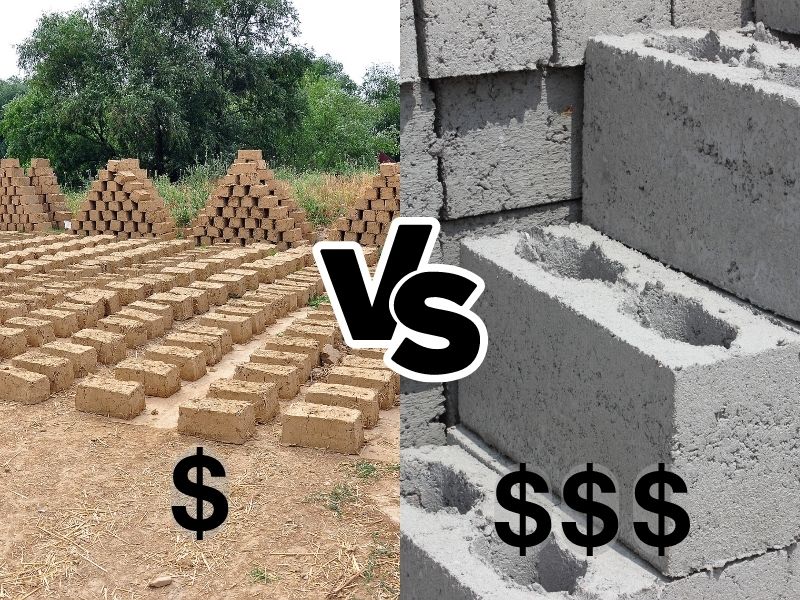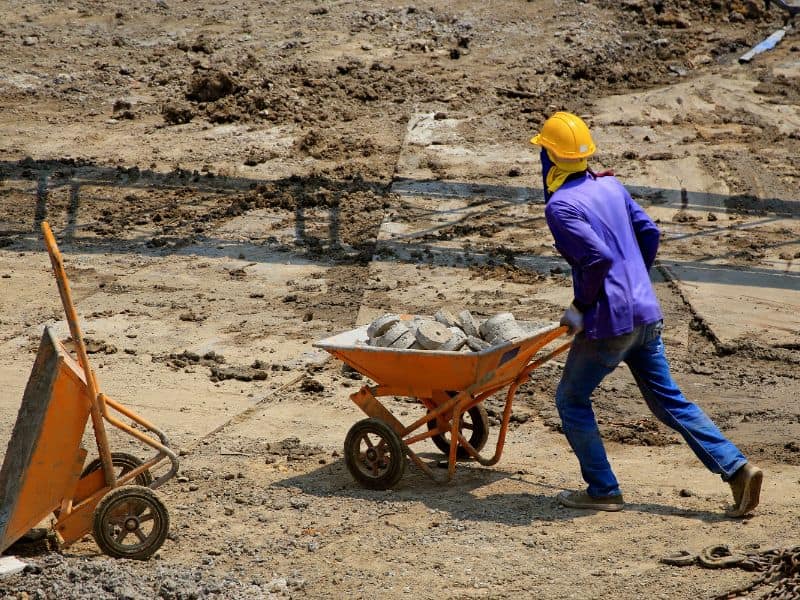Cost of Adobe Construction vs. Conventional Construction

Building a home from scratch is an expensive and complex undertaking. You must consider material and labor costs, relevant permits, and maintenance.
It’s surprisingly difficult to get accurate figures on the true cost of building work using different types of construction techniques, and this is especially true when it comes to comparing adobe with conventional approaches because there are so many variables at play.
For example, one project might have all the material to produce the adobe bricks available on-site, with the homeowners doing the lion’s share of the work, whereas another project might import aggregates to the site for production of the adobe bricks, bumping up the overall cost.
So, what is the cost of adobe construction vs. conventional construction?
Owner-builder adobe construction costs between $55 and $85 per square foot, depending on installed features. However, you should expect to pay more if you hire a contractor. On the other hand, conventional construction using concrete costs between $100 and $250 per square foot.
In the rest of this article, I’ll compare the cost of adobe construction vs. conventional construction in terms of labor, materials, and maintenance. This will help you determine the best option for your project when choosing between adobe and conventional construction. Let’s dive right in!
Adobe Construction Vs. Conventional Construction: Material Costs

The cost of materials accounts for the highest percentage of the total construction cost for conventional buildings. Materials account for 70 percent of the total cost in most traditional construction projects.
However, this is different for sustainable building methods like adobe.
Adobe bricks, the primary material for adobe construction, are obtained for free or cheaply from the earth. All you need to make adobe bricks is sand, clay, straw, and water — ingredients found almost everywhere.
If your area doesn’t have the right sand and clay proportions (70% sand and 30% clay), you can amend the soil by adding either sand or clay, whichever is required. This will help you save on the cost of materials.
It’s worth noting that despite conventional construction materials being costly, transporting these materials to the site adds further to the initial cost.
Transporting building materials accounts for between 39 and 58 percent of the project’s logistics costs.
You don’t have to worry about transportation for adobe bricks because the raw materials are usually sourced locally, and the bricks can be made on site.
Adobe Vs. Conventional Construction: Labor Costs

Usually, labor accounts for about 30 percent of the total construction cost for conventional construction.
Realistically, making adobe bricks is labor-intensive due to the following processes:
- Mixing sand, clay, straw, and water in the right proportions.
- Trampling the mixture to form adobe mud.
- Transferring adobe mud into forms to shape the bricks.
- Drying the bricks for about three to four weeks, depending on the weather.
So you should expect to pay more in labor costs to make adobe bricks since accomplishing the above processes requires patience and dedication.
As if that’s not enough, making adobe bricks requires skilled personnel. You must mix the ingredients in the right proportions, tamp the mud into wooden forms, and sun-dry the bricks thoroughly to make them stronger.
Unfortunately, most trade colleges focus on traditional construction skills like building with concrete blocks, plumbing, and wiring. This means getting a skilled adobe craftsman can be difficult and expensive.
You can lower labor costs for adobe construction by going the do-it-yourself route. Adopting the owner-builder approach can help you save up to 50% of labor costs.
However, it’s worth noting that the DIY approach requires hard work and dedication. From mixing the ingredients to forming the bricks and drying them, you’ll do everything yourself.
Moreover, you should only go the DIY route if you know what it takes to make strong, durable adobe bricks. Some key steps you must know include the following:
- How to choose suitable soil.
- How to mix the ingredients in the appropriate proportions.
- How to form the bricks
- How to dry the bricks after forming.
Only proceed if you know how to do these things, otherwise, consider hiring an experienced contractor — you don’t want to save on labor costs and end up with fragile adobe bricks that won’t stand the test of time.
Construction Labor

You may have noticed that in the above section, we only focused on labor costs due to the production of adobe bricks. What about labor due to construction activities?
Conventional construction entails many physically demanding activities. For instance, it involves nailing, sawing, and carrying heavy pieces of wood and concrete. Consequently, these activities mean you need more labor, translating to more labor costs.
On the other hand, adobe construction requires a modest amount of labor during the building process. You only need to apply mud-based mortar to the bricks and stack them in courses. This helps lower the amount of labor and, consequently, costs.
So, what’s the verdict for labor costs?
Well, adobe construction wins hands down when it comes to labor costs because it’s a simpler process.
Moreover, adobe construction will be even cheaper if you know how to make the bricks yourself for a completely DIY approach.
Adobe Vs. Conventional Construction: Maintenance Costs
Adobe bricks are highly susceptible to destruction by the elements.
Water is the main threat since it causes erosion and softening of adobe bricks, resulting in poor structural integrity.
Although adobe houses are known to last centuries, their durability is subject to sufficient maintenance and protection against water damage.

Moreover, according to the Old House Journal, adobe houses are prone to frequent swelling and shrinking. Therefore, they require constant maintenance in terms of replastering and patching the surfaces.
This means that adobe houses can be costly to maintain. You must patch and replaster them regularly with breathable plasters like lime or stucco. Moreover, regular inspections are necessary to check for and repair erosion.
An excellent way to protect your adobe walls from water damage is by erecting a pitched roof with at least twelve to sixteen inches (30 to 41 cm) of overhang.
Conventional construction requires minimal maintenance since these buildings are not highly susceptible to destruction by the elements. If you use quality materials and employ experienced personnel, you can rest assured of a strong structure that won’t require a lot of regular maintenance.
More often than not, all that’s required of you is to inspect and fix minor damage to your conventional house.
Frequently Asked Questions
Are Adobe Houses Cheaper to Build?
Adobe houses are cheaper to build because they use readily available materials like sand, clay, and straw. Moreover, adobe construction requires a modest amount of labor because it’s a simpler process compared to conventional building.
Why Are Adobe Houses So Expensive?
Despite being cheaper than conventional construction methods, the expense of adobe houses is surprising to some people and comes from making adobe bricks, which is quite labor-intensive.
Making adobe bricks entails mixing the ingredients, trampling, and drying. These processes require a lot of labor, making adobe houses more expensive than many people expect.
Final Thoughts On The Cost of Adobe Construction vs. Conventional Construction
Although building an adobe house costs significantly less than conventional construction, they can be expensive to maintain.
Although costly to build, conventionally constructed houses require minimal maintenance.
If you’re looking for an eco-friendly material with minimal environmental impact, adobe construction can be an excellent choice.







